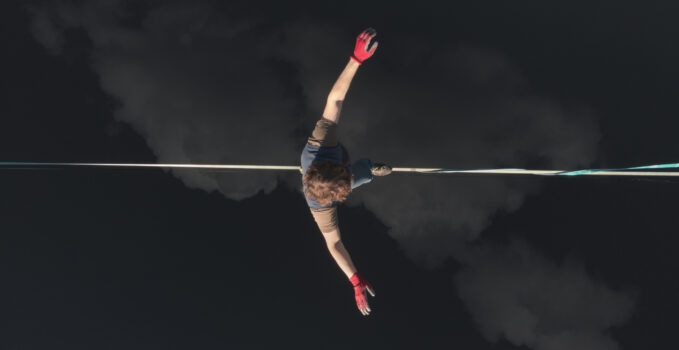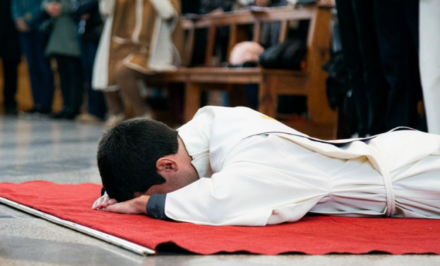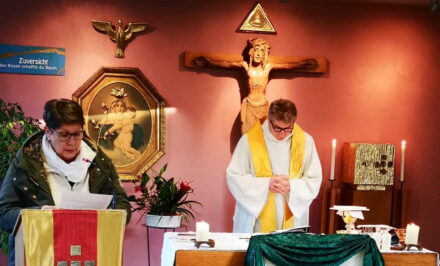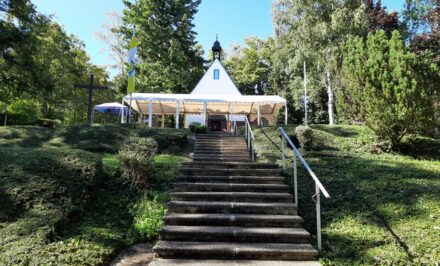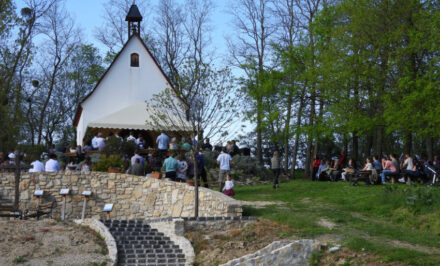Fr. Elmar Busse •
If you analyse the publications about Fr. Joseph Kentenich using qualitative content analysis methods from the communication sciences or marketing keyword research, then you will find the snow-white beard as the image mark or logo “Kentenich”, and as a keyword: “early canonization”, “always”, and since 2020: “abuse”. In the following series of articles we want to take a different look at Kentenich: neither the bearded St. Nicholas nor the candidate for canonization, but neither the man suspected of abuse of power or spiritual abuse. —
The very positive response to the texts of Fr. Elmar Busse, written some 30 years ago and slightly updated, has motivated him to present in the same style other “different views” of Fr. We also hope that these new texts will allow, beyond the usual attributions, a new and lively look at the multifaceted figure of the Founder, thus awakening the curiosity to approach him more intensely. We believe it is worth it!
60 meters above St. Stephen’s Square
On May 24, 2013, there was a special attraction in Vienna that could be admired from St. Stephen’s Square. Tyrolean Christian Waldner swung 60 meters from the great Steffl Tower to the Heidenturm Tower and back. He covered the distance, barefoot, on a 2.5 cm wide rope. Of course, he attached himself to the rope with a belt.
Once, at a meeting with families in Memhölz, I tried to hold myself for a few seconds on a balancing rope that one of the participants had stretched between two trees only 15 cm above the ground. To no avail. I admire even more the athletes who not only hold on to such a line, but also make jumps and land safely on it again. During my rehab, we also trained balance exercises in gymnastics. But they were much, much easier in terms of the degree of difficulty. What signals do the nerve sensors send to the brain and how do you have to counteract them with the corresponding muscles to be able, for example, to stand on one leg and make movements with the other? People with hearing problems can recount their sad experiences when the organ of balance goes out of control.
Maintain polar values in equilibrium
Also, in the development of the personality a balance is always necessary. Because all the values we strive for have a polar value. Generosity is just as important as thrift. Allowing freedom is just as important in the upbringing of children as setting limits. Spontaneity is as much a part of a lively existence as perseverance. It is often necessary to keep secrets, but spiritual closeness can only grow where I open myself with trust and can share.
Father Kentenich spoke of the principle of the tensions that run through all of creation. One of the unfortunate consequences of original sin is that we all have in some way a negative side. That is, we have a natural tendency to keep enlarging what comes easily to us to the point of exaggeration. And then a value becomes its degeneration. It is not for nothing that there is a saying “too much of a good thing! Perseverance can turn into stubbornness, spontaneity into chaotic behavior, which makes it very difficult to work with this type of person. A person who over-cultivates his need for security becomes a dull person. The adventurer may underestimate the risks and end up tragically.
Tensions
The following text makes clear how important Father Kentenich considered the principle of tensions or polarity:
God, in his inscrutable wisdom, knows how to brilliantly exploit the infinite wealth of tensions that are fundamental in all these principles for the realization of his loving plans for human society. The same applies to the relationship between nature and grace and the individual persons within the Holy Trinity. Here on earth, God is concerned with the ideal of unity of tension, which in the visio beatae leads to a unity of perfect order.
We try to imitate this mysterious form of government and wisdom of the eternal Father God as perfectly as it is possible for a mortal human being with the burden of original sin. So, we briefly formulate the divine principle of government for our use as follows: authoritarian in principle, democratic in application. To put it more clearly: in our government we rely unwaveringly on authority, but in the application and effect of that authority we are, like God, extremely sensitive and considerate of the individual and social needs of nature. Or: we are authoritarian in principle, but largely democratic in the application of this authority. In this way we believe that we are imitating, as far as is possible for human beings, God’s omniscient and unattainable form of government.
Following his example, wherever we are allowed freedom, we work in the best way with the laws of tension established in nature by the Creator and King of the World. We repeat: We are “authoritarian in principle, but democratic in application” when dealing with people and leadership management.
The phrase sounds very simple. I would almost say it sounds innocent enough. We have heard it countless times in courses, and I believe that not infrequently we have needed it ourselves. But have we ever realized its full significance? Have we ever realized that we hold in our hands the key which makes the complex history of Schoenstatt fully comprehensible from the human point of view: whether it is a question of organizational matters, of government or of personal leadership”? [“Crisis of the Forms of Government”. Study September 1961].
Opposites attract…somehow
Father Kentenich, who was a good observer and educator, spoke again and again of “agere contra” (= to act in opposition) and “agere a natura” (to act according to nature). Both strategies are part of inner freedom, fundamental for mental and spiritual development.
If, at the beginning of a relationship, the spark often jumps out, it is precisely because the other person personifies so clearly the other pole, which is somehow missing in oneself, which immediately becomes visible and palpable.
The spontaneous student admires the persevering classmate. The persevering student lets himself be pulled out from behind the books by his girlfriend and does crazy things with her so as not to become a nerd. But years later, when they get married, the accusations begin, “Stubborn guy!” – and in retaliation, “Chaotic old lady!”. The two haven’t changed much, but their view of each other’s polar courage has changed. From gold digger to dung beetle. Only in ancient Egypt was the dung beetle a symbol of good luck. In relationships, the dung beetle’s gaze is the cause of chronic and exhausting discussions. For each criticizes the other from the pedestal of his own value, without admitting that a small portion of the dung beetle’s polar value would do him good.
To sharpen the vision of values, their polar values and their respective deteriors, you can play a little game when driving a car together: one names an adjective and the other must find both the polar value and the two forms of exaggeration. If you start to fight, take a breath, and stop, analyse the situation, and ask yourself if you are back at the beginning of the tension. From there, the step toward humor-laden mercy is not far off. You are never done with self-education. Until the end of life it is about enlightened collaboration with redeeming grace. Sometimes it can be hard work, but often it is also a joy to face the challenges.
Buds and annual rings
Although Father Kentenich always strove for balance within the framework of the principle of tension, at the same time he encouraged unilateralism in the processes of soul development. In his pedagogical talks he repeatedly spoke of the laws of growth and characterized healthy growth as a slow growth from within, from an organic totality to a new organic totality.
In our context, it is interesting to note that life grows simultaneously but not uniformly. We can observe this especially in the buds in spring. There we witness significant changes in a few days. We cannot observe that a tree grows a new annual ring. Applied to the growth of the soul, Father Kentenich encourages educators to promote especially what is just emerging as a bud – knowing full well that this is often one-sided and does not necessarily correspond to objective standards of values. But since introspection combines the joy of discovery with curiosity and enthusiasm for what is newly emerging, the educator should go along with it and encourage it instead of pointing fingers at objectively higher values and simply dismissing what is emerging as an unimportant side issue.
Continue with natural starting points
I still remember well how one of “my” former camp participants found himself under the influence of a dogmatically well-versed but psychologically clueless spiritual father and thus fell into a depression. The repeated insinuation that love of God is the ultimate to which a Christian should aspire only created in him a feeling of helplessness. The young man put it this way, “I constantly feel like a mountain climber standing before a 2,000-meter cliff and not knowing how to climb.” When he broke away from that spiritual advisor, he regained the courage to face life, found joy in competitive sports, discovered his interest in medicine, graduated without problems and is now a passionate and well-known physician.
We know the expression “the most beautiful thing in the world” from commentary on soccer matches. And we can see on the screen what emotions this ‘triviality’ can provoke. And, on the other hand, we can see how, for many children and young people, the desire to be at the top can motivate them to train regularly and with discipline. Not only do muscles grow, but character grows as well. Of course, professionals also must ask themselves what they will do with the rest of their lives once their time as professional players is over.
In the life of faith, too, we know a hierarchy of truths of faith. At the same time, we observe that for some Christians contact with deceased relatives is subjectively more important than love for God. This is observed on All Saints’ Day, when the faithful, who usually do not go to church, stand at the graves of their loved ones, and insist that a few drops of holy water fall on their graves.
Father Kentenich repeatedly recommends to those who accompany spiritually, to assess the points of attachment, knowing the one-sidedness. Where are the sprouts? What is driving from within? What is coming to light? What values inspire enthusiasm? What creates resonance? Giving space to this in the hope that the one-sidedness will become “rounded” and “harmonious” during development was one of the concerns of the educator of the Father Kentenich movement.
Unilaterality and balance: that was not a contradiction for Father Kentenich. There is space and time for both in a healthy mental development.
These are also the articles in the “MTA”
For this, a brief contribution of research on Father Kentenich’s concept of communication, based on the “MTA” magazine:
In dialogue with Professor Rademacher, Fr. Kentenich says in 1917:
“All individual contributions are arranged according to the laws of a planned strategy. All forces are mobilized and played off against each other, not only to keep each other in balance, but also to propel each other to the top. That is at least my idea of the wording. In this way, one contribution complements and corrects the other. Once the sense of strength is strong enough, the counterbalance comes immediately after or in one of the following issues in the other’s confession of his helplessness and unshakable confidence. (…)
I can control the effect of this method quite precisely. It is an application adapted to the circumstances of my – I might say proven – way of working here in the Congregation. It puts a lot of emphasis on people educating themselves and each other”.
Balancing artist as editor.
Original: German 09/09/2023. Translation: Melania Fernández, San José, Costa Rica


